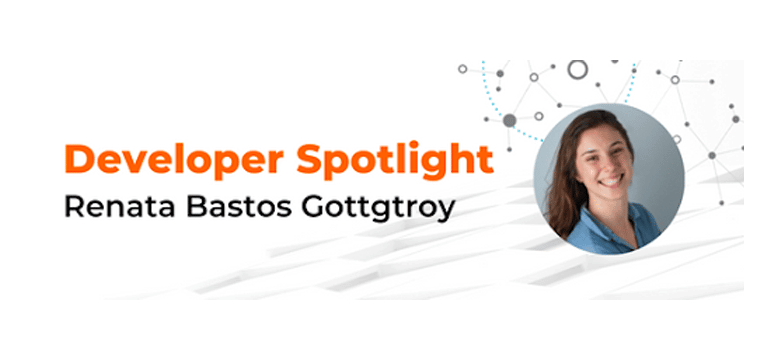Developer Spotlight: Renata Bastos Gottgtroy
- Blog >
- Developer Spotlight: Renata Bastos Gottgtroy

TigerGraph Developer Spotlights allow you to get to know people using TigerGraph around the world to create powerful connected data solutions answering countless use cases.
Meet Renata Bastos Gottgtroy
Learn about Renata Bastos Gottgtroy, Ph.D. Candidate at Auckland University of Technology, and how she went from being a high-level athlete to solving problems in the healthcare industry using graph!
Tell us a little bit about yourself; where are you from and what are you currently working on?
I’m originally from Brazil, but my family and I moved to New Zealand when I was seven years old. Then ice hockey took me to Canada, where I completed my undergrad degree in Kinesiology and Health Sciences, focusing on biomechanics at York University. I’ve always loved human movement, numbers, and physics, so that was a great match. I did my honors thesis in spine biomechanics, and when thinking about my Master’s or Ph.D., I really wanted to stay in that area. I also wanted to expand my skills in data science, so I reached out to my supervisor, whom I admire, to see if there were any projects I could do with her. There wasn’t anything in biomechanics, but there was an idea to do a project that involved working with concussion (mild traumatic brain injuries) patients. Because I had suffered from a concussion, I took the opportunity to work on this project. I started working on my Ph.D., looking at how to help concussion patients using a data science approach. Currently, I am working on a project that involves understanding and making recommendations for concussion patients’ journeys through the healthcare system.
What interested you in TigerGraph, and what has it been like working with the platform?
When I was working on my Ph.D. project, I started seeing that what needed the most improvement was the patient journey through the healthcare system. I started looking into other projects that other people had done, and I came across a paper in which the writers had used graph analysis to see the trajectory of patients from one disease state to another. I thought that was very interesting as at the time I was creating a conceptual entity-relationship model for my project and realized its similarity with graphs. So I started looking into graph further, which is how I came across TigerGraph.
I’ve really enjoyed working with TigerGraph because for someone like me, who doesn’t have a computer science background, everything is very user-friendly. Getting started with the platform was easy, and I love the visual aspect of it. I’m working with healthcare data, and there are many relationships and connections between data points. Before I started using graph, it was frustrating to look at my data. When I shifted to TigerGraph and could visualize my database, that was a real game changer.
What has surprised you most about working with graph technology?
It really does represent the world the way that it is. One thing that surprised me was that when I started designing my graph, I realized how much I had been taught to see the world through a relational database perspective. So although graph databases are user-friendly and intuitive, they cause you to have a complete shift in perspective when thinking about data.
Another thing that surprised me was that everything is straightforward after getting used to the structure and GSQL. Not to say that I can code very easily right now because, as you know, I have many questions and attend the TigerGraph Graphé (office hours) frequently, but overall graph just makes sense to me. I don’t have a computer science background, and sometimes that can be overwhelming, but this wasn’t, so I was pleasantly surprised.
What’s been the most influential resource for your career?
Although I think that people really help you pivot and turn and help you grow, I have to say that my most influential resource has been that I was a high-level athlete. I say that for a lot of reasons. First, it has helped me be determined and confident. Second, it helped me learn to work in teams, and third, it taught me to push myself to my limits. The last piece has really been a double-edged sword. I have found that outside of the sporting world, not setting boundaries or listening to my body does not work well. So, while being an athlete has been a great resource for my career, it has also been a great learning point throughout my Ph.D. journey.
If you were going to write a book, what would it be about?
This is a funny question because I was talking about this with my best friend before you and I started talking. She said, “anyone who knows you knows you wouldn’t write a book.” She said that because I’ve always been the numbers girl, never the words girl. But I have always liked sharing what I’ve learned throughout life, so if I were to write a book, I would probably write about the value of our bodies, body over mind, not mind over matter. How listening to my body and living through my body has changed and continues to change my life. I read a lot of self-growth books, so that’s probably what I would focus on writing about.
Anything else you want to share about yourself?
My passions surround biomechanics, movement, and body-focused well-being. I would love to one day be able to work on projects that combine physical activity and well-being with data science. I also love traveling around in my camper van, so if I could work on physical activity-related data science projects while traveling, that would be my dream.
Connect with Other Developers
There are hundreds of TigerGraph developers talking daily in TigerGraph’s developer chat. If you would like to get help from others, discuss ideas, or just meet other graph enthusiasts, check out TigerGraph’s Developer Chat!












